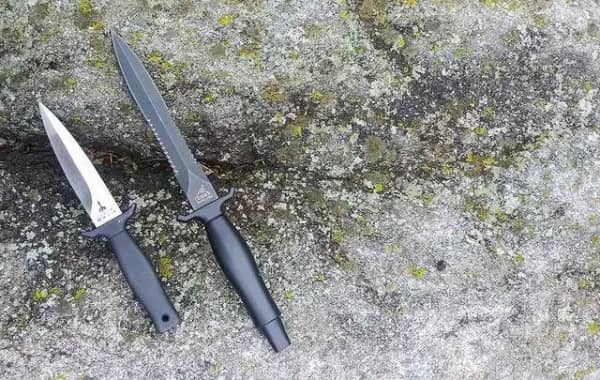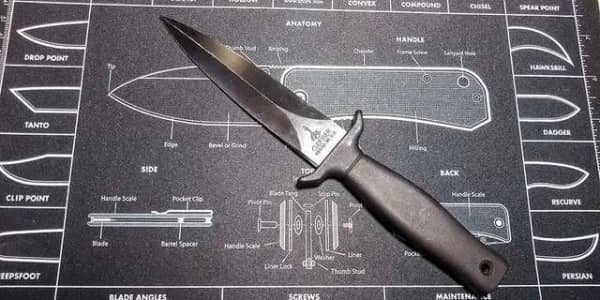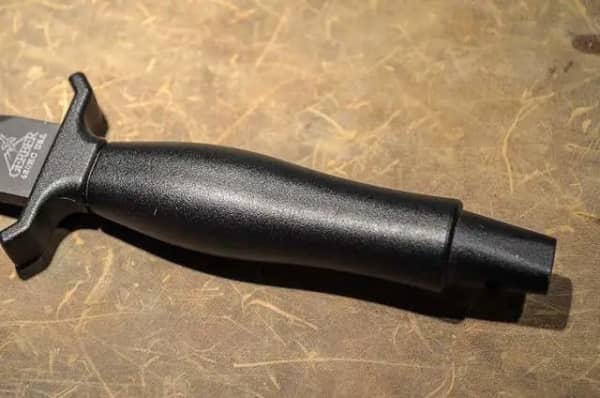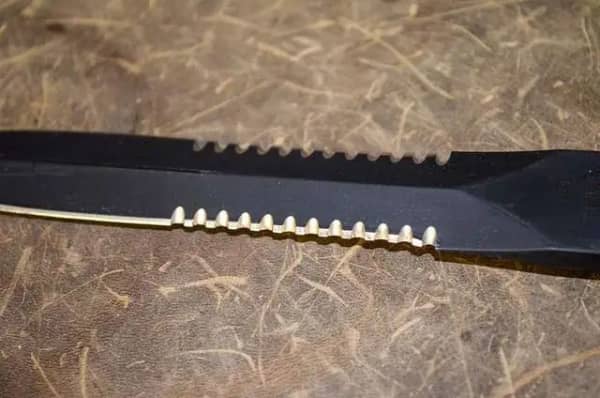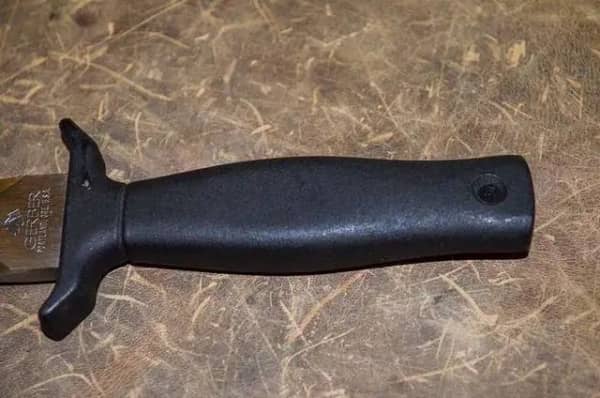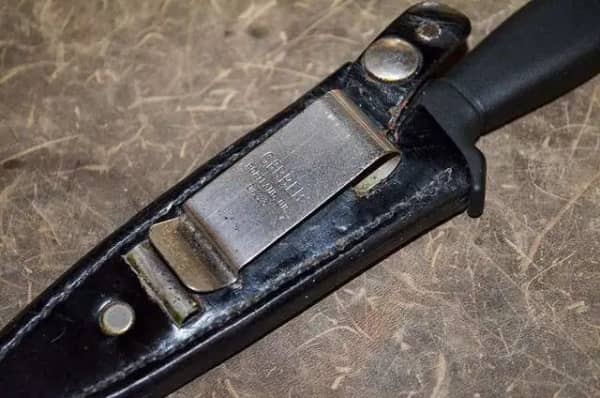It was 1983, just after Christmas. As a teenager, somehow lost in the mists of time, I went to the Mayfair Shopping Center with my mum. We don’t go there very often as it’s the furthest mall from home, but whenever we do I make sure to stop by and check out the items from Tableware World.
It’s fairly small as far as an arcade goes, but it has all sorts of sharp and crafty goodies. On this trip, I found a boot knife called the Mark 1. It’s double-edged, very sharp, and I’m hopelessly smitten with it. The list price was around $50 if memory serves me. Today it’s about $140. To this day, without knowing how I did it, I managed to convince my mom to lend me the money to buy it. Well, she bought it because they weren’t going to sell a dagger like that to a 13-year-old.
There is no denying the impact the Gerber Mark 1 and Mark II have had on the knife industry over the years
When school started after the holiday, my mother gave me clear instructions not to leave the house with a dagger. One day, I was called into the office to talk to her on the phone. It seems like she checked my room, found the knife was missing, and called the school to talk to me. I know where it is, it’s in my right boot, where I just put it after showing the knife to a few friends in the bathroom. I freaked out about that stunt, but luckily the school never found out. Today, that might be a dismissal-level offense.
This is part of the initial design work created by Bud Holzmann and submitted to Gerber
So that’s my introduction to the iconic Gerber dagger. A friend of mine lost that dagger a few years later while we were hiking, but I’ll never forget how cool it was. Let’s look at the history of two legendary knives, the Mark 1 and Mark II.
|——Mark II
Clarence “Bud” Holzman was a captain in the U.S. Army with the 101st Airborne Division during World War II. He was awarded the Bronze Star for bravery under enemy fire. After retiring from the military, he lived with his wife in Portland, Oregon, and worked in car sales. A few years later, in the 1960’s, he began designing combat knives. He wanted to create something suitable for use by the US military in Vietnam.
Modeled after another legendary knife, the Fairbairn-Sykes Dagger, this knife is a double-edged and deadly wasp-waist blade. The handle is oval rather than round like the F-S dagger, which allows for easier indexing in the hand.
In May 1966, he presented the design to the Gerber Legendary Blades. By July, prototypes had been built and sent to Fort Lewis for testing and evaluation. Feedback received was used to revise the design and a second prototype was sent. By 1967, the Gober Mark II was in production.
It was never officially issued to US troops in Vietnam but can be purchased through Base PX. The Mark II became popular in what we call the special operations community, especially those in the MACV SOG unit. However, in the 1970s, the knife was deemed too brutal in appearance and was withdrawn from base distribution. Gerber countered by adding serrations to the blade, then marketing it as a survival knife rather than a combat knife specifically. With these changes, the PX system is on sale again.
By 1998, the knife’s popularity and wholesale had declined, and the Mark II was discontinued. However, the knife was brought back into production in 2008 following strong demand from customers.
Bud Holzmann passed away on April 27, 2010, surrounded by his family. He was buried with military honors at Willamette National Cemetery in Oregon. His knife designs remain among the most famous of all time.
|——Mark II design
The Mark II features a long, double-edged blade that measures 6.625 inches from guard to tip. It narrows slightly near the middle, giving it that distinctive wasp-waist silhouette. The cross-section of the blade looks like a narrow diamond.
The handle is one-piece cast aluminum, and some versions have a texture that came to be known as “cat’s tongue”. To provide a positive, secure grip under challenging conditions such as wet hands, part of the production process involves spraying the aluminum handles with molten steel. The steel slightly melts the aluminum and bonds with it, creating a non-slip surface.
The dagger has only one real purpose, it’s not carving sticks or building emergency shelters
This was used in earlier releases and then in some special releases. The rest had Armorhide painted on the handle, which served a similar purpose, and went from gray (1968-1977) to black (1977-present). There are also some limited releases in yellow and orange.
Here’s an ad in the Saigon Post circa 1966 showing the Gerber Mark II and declaring it “deadly”
Originally, the blades were made of L6 steel. This is a high carbon steel that works well, but like all high carbon steels, is prone to rust or corrosion. Gerber switched to 440C stainless steel in 1982 and later produced some 420C models as well.
Both zigzag and non-zigzag models have been manufactured over the years, but zigzag models seem to be the most common today.
|——Mark II in film and television works
The Mark II has been a fairly popular blade in Hollywood. Remember the scene in “Alien” where Lance Henriksen’s robot Lance Bishop grabs Private Hudson’s (Bill Paxton) hand for a knife game and pokes the knife back and forth between his fingers?
A few years ago, in “Road Warrior,” the handle of the Mark II was seen sticking out of Max’s (Mel Gibson) boot.
This is a leaflet printed and distributed by Gerber promoting the Mark II as a combat knife
Steven Seagal’s Casey Ryback in “The Siege” in 1992’s last stand with William Strangex (Tommy Lee Jones) One was used in one battle. Most recently, the Winter Soldier (Sebastian Stan) used one while fighting Captain America (Chris Evans), in the aptly titled Captain America: The Winter Soldier.
This flyer, produced by Gerber from 1972, changes the advertising angle from a combat knife to a survival tool.
In literary circles, the Mark II is the dagger recommended by Rex Feral in his 1983 book The Killer. Ostensibly written by a professional assassin who turned out to be a woman who pieced together information from TV shows, movies and novels, the book was eventually pulled after publisher Paladin Press was embroiled in a lawsuit.
Paul Rubinstein, the partner of hero John Thomas Locke in the “Survivalists” series written by Jerry and Sharon Ahern, was awarded the Mark II by Locke.
|——Mark 1
Mark 1 came after Mark II, albeit numbered. The goal was to create a knife that could be legally carried in more places than the Mark II. Many places do not allow the use of 6-inch double-edged daggers.
In response to consumer demand, Gobo created a smaller dagger called the Mark 1. The company’s designers not only shortened the blade, but also slightly reconfigured the handle. It comes with a leather sheath fitted with a clip designed for boot carry.
The Mark II can be seen in an upside-down position on its left side
The Mark 1 entered production in 1976. It came in several different configurations over the years before it was finally discontinued in 1997.
In late 1979, in an effort to create a dagger that wouldn’t break the law for their customers, they launched the Command 1. Almost identical in size and shape to the Mark 1, it differs in one important way. Instead of being sharpened on both sides, the Command 1 is fully sharp on one edge, while the top third of the other side is jagged. That’s enough to make the Command 1 legal in many areas where double-edged daggers are banned.
The Command 1 was produced until 1994. As with the Mark 1, there have been some changes along the way, mostly regarding the steel used.
|——Mark 1 design
The Mark 1 is a double-edged dagger with a blade length of 4.75 to 5 inches, depending on the year of manufacture, for an overall length of approximately 9 inches. From 1976 to 1981, the blade was L6 high carbon steel, just like the Mark II. At that time, the company started using 440C stainless steel. The Command 1 is made only from 440C stainless steel.
Executioner #104’s cover shows protagonist Mack Bolan holding what appears to be a Mark 1 dagger
Aluminum handle measures 4 inches long. It’s one piece and has a lanyard hole at the bottom.
|——Mark 1 in film and television works
The Mark 1 didn’t get as much screen time as its big brother, but superspy James Bond used one in 1997’s Tomorrow Never Dies.
Mack Bolan, hero of hundreds of novels, holds a marked Mark 1 on the cover of Executioner 104 – Devil’s Horns.
The aluminum handle on the Mark II is contoured and slightly oval
To be honest, the sawtooth on the Mark II wasn’t that useful
Both the Mark 1 and Mark II are often imitated. Speaking strictly from my own experience, the Mark 1 in particular is one of the most cloned knives I’ve ever seen. It seemed like every flea market and pawn shop in the 1980s was filled with Mark 1 knockoffs. Most of them are no doubt made overseas, and they are all of dubious quality. Of course, when we were kids, we didn’t know much about it either, buying by the dozen.
Like the Mark II, the Mark 1’s handle has some texture to help you maintain a grip
Marketed as a bootknife, the Mark 1 has a clip on the sheath instead of a belt loop
From the jungles of Vietnam to the belts and boots of countless civilians across the country, these knives have had plenty of carry time. Every knife has a purpose, and while the double-edged dagger’s raison d’être isn’t exactly bushcraft or food preparation, there’s no denying the impact the Gerber Mark 1 and Mark II have had on the knife industry over the years.
Нажмите, чтобы получить больше Shieldon EDC ножи и инструменты веселье.

